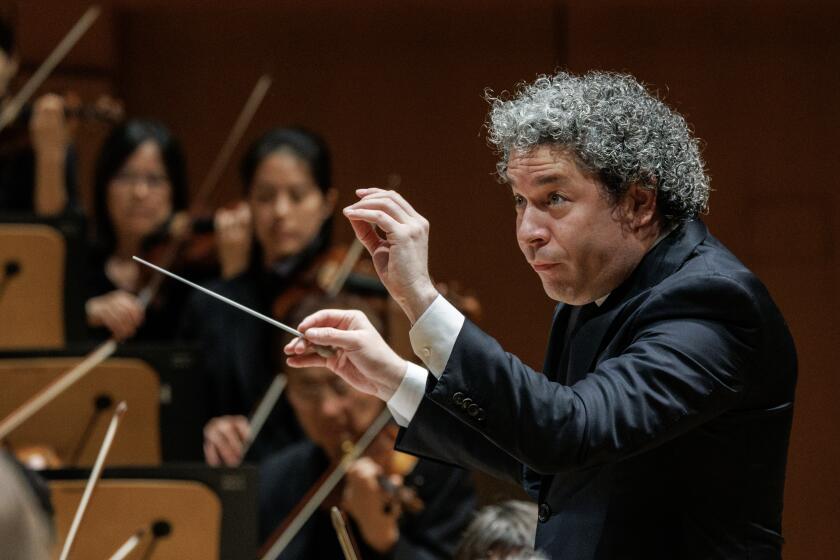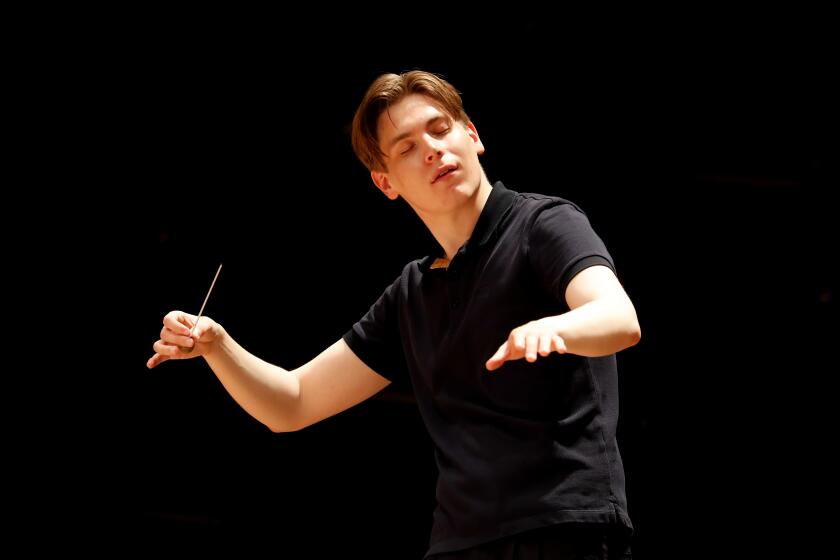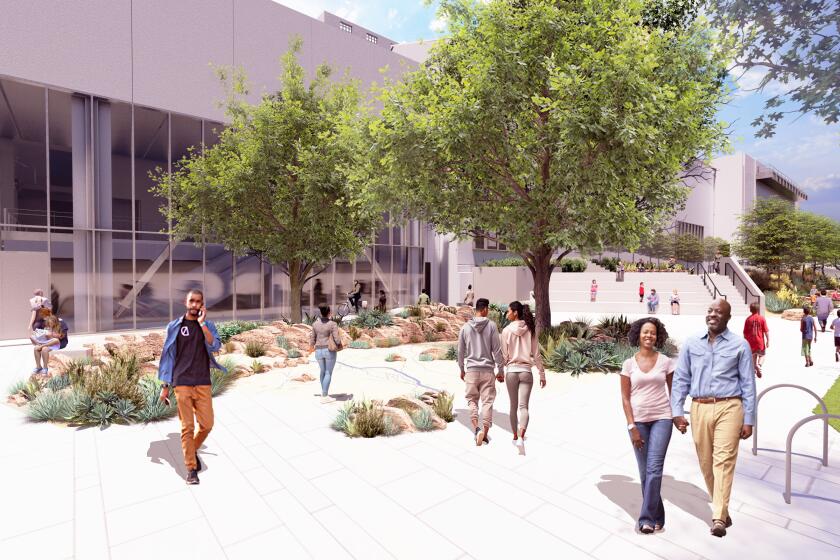Column: What is the state of opera in L.A.? OperaFest LA tells only half the story
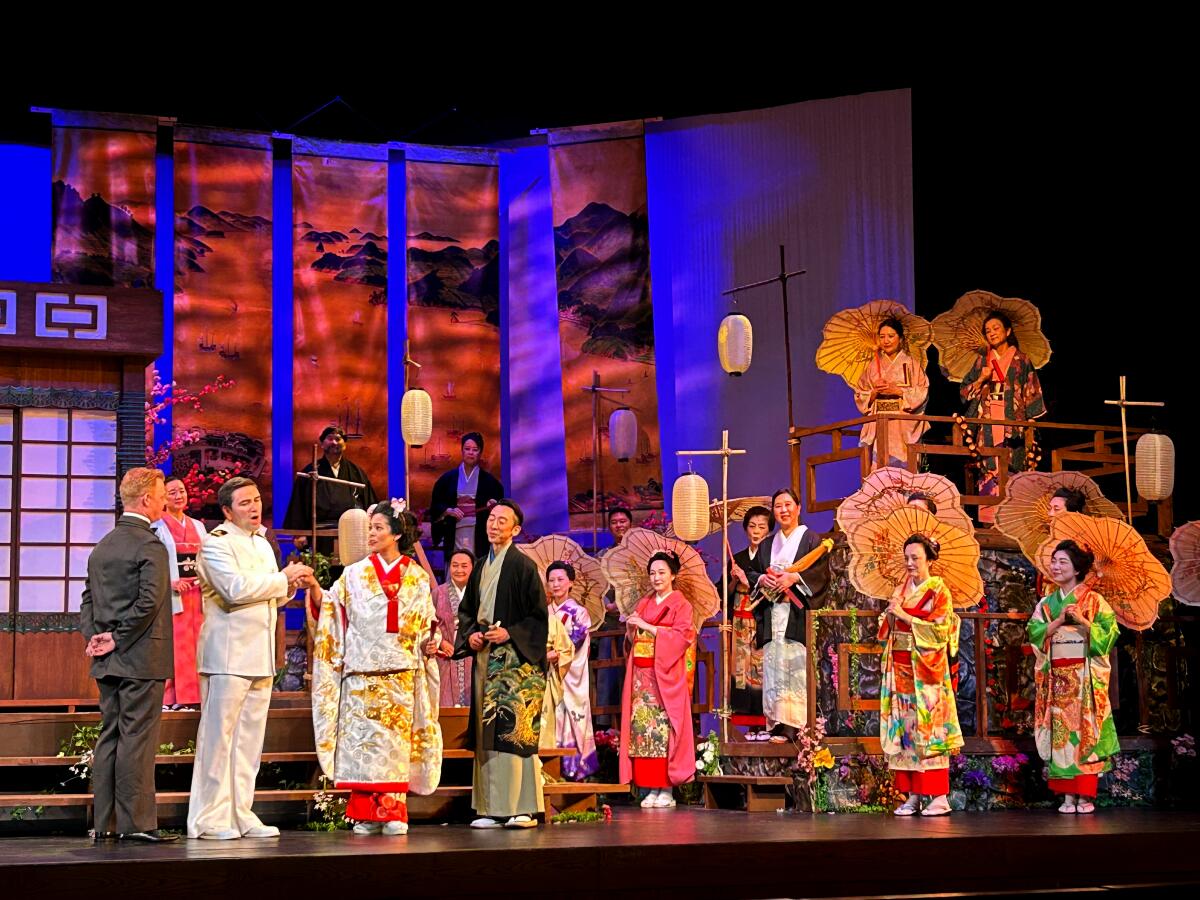
- Share via
Los Angeles is not, historically, an opera city. Only in 1986 did it finally found a resident company, Music Center Opera, now Los Angeles Opera. Nor do we boast an actual opera house. The Dorothy Chandler Pavilion is a multipurpose theater. Dorothy Buffum Chandler disliked opera.
Yet before we became Tinseltown, we had, count ‘em, three major opera houses downtown. At 1st and Main streets, on the site of the Caltrans building, sat the Grand Opera House. Mason Opera House was but two blocks away on Broadway. Around the corner from the Grand, Puccini’s “La Bohème” had its U.S. premiere in a 1897 touring production at the Los Angeles Theatre .
Then again, not much opera was actually presented in these grand opera houses, rather Gilbert and Sullivan, music revues of all sorts and straight theater. We basically made it up as we went along, which is essentially what opera has always been in L.A. and why we ultimately have become, at least some of the time, America’s most progressive, audacious, irreverent and relevant opera center — and possibly the world’s most curious. Everything goes.
After three months away, Dudamel is back for a month to revive ‘Fidelio’ and oversee his Pan-American Music Initiative. But then he’ll be gone again until end of August.
This week we are also opera central, home to this year’s annual conferences of the World Opera Forum, which began Monday, and Opera America, which opened Wednesday. Opera makers of all sorts and from all continents have checked into the Omni hotel downtown. Monday afternoon in a packed Zipper Concert Hall at the Colburn School, a 16-strong panel of administrators, composers and performers representing Zambia, Australia, South Africa, Ukraine, Germany, France, Brazil, Argentina, Britain and the U.S. brought their perspectives on “Making a Case for Opera in the 21st Century.” Many of the 400 opera-tives in the audience chimed in with responses typed into their phones and projected on a large screen.
Opera is grandeur. Opera can uniquely deal with grand ideas. Opera is greater than the sum of its arts. Opera changes your sense of time and space. Opera is about telling stories. Opera magnifies and connects you with the unamplified human voice. Opera can and should connect you with your community. Opera is fun and glamorous. Opera is (unlike opera conferences) an escape from the phone. Opera brings together people from different disciplines and, as the panel marvelously demonstrated, different cultures.
All true, but what might L.A. bring to the discussion?
L.A. Opera is acting as host. An ad hoc “OperaFest LA” has been thrown together this week to advertise our wares. Three of our major local opera companies have productions running through the weekend. In addition, curiosity-seekers can check out quirky, only-in-L.A. offerings from smaller outfits.
Still, much of what makes the case for L.A. as a headquarters for opera in the 21st century — notably the Industry, the Los Angeles Philharmonic and the work of L.A. director Peter Sellars — are either happening elsewhere or coming a week after the conference. You cannot gauge opera or the arts in L.A. without them.
I took in last week the big shows that our opera visitors are most likely to attend. These are the L.A. Opera production of Puccini’s “Turandot” designed by David Hockney, a staging by Pacific Opera Project of Puccini’s “Madama Butterfly” and the West Coast premiere of Kate Soper’s one-woman experimental “Ipsa Dixit” at Long Beach Opera.
Klaus Makela, appointed music director of the Chicago Symphony at the age of 28, has been likened to Gustavo Dudamel. Why orchestras’ chasing of youth could have downsides.
Although no longer known for boldly progressive main stage productions — the likes of Achim Freyer’s Wagner “Ring” cycle (far and away the most imaginative of any American “Ring”) and a series of Robert Wilson stagings — L.A. Opera delivers a “Turandot” that does at least provide local color. Hockney designed his “Turandot” sets for San Francisco Opera and Chicago Lyric Opera, where they were first used in 1992. Still, he was at the time an Angeleno. His blues were the Pacific Ocean. His reds were Malibu sunsets.
The Hockney “Turandot” dazzles. He transformed objectionably quaint Chinoiserie of yore into a vibrant East-West artistic fusion. But of the seven operas Hockney designed (including a wondrous “Tristan und Isolde” for Music Center Opera in 1987), his “Turandot” is the most problematic and holds up least well.
Puccini died in 1924 before finishing “Turandot,” which represented a new direction for the composer, away from melodrama and, instead, embraced a new air in music, be it from Mahler, Debussy, Schoenberg or Stravinsky. He also embraced a very old air in Chinese Taoist philosophy. “Turandot” is a riddle opera of Confucian confusion for which Puccini hadn’t found a solution. After the composer’s death, a hokey big operatic ending got tacked on with a showy duet by a second-rate composer, Franco Alfano.
We’ve moved on. In 2002, L.A. Opera gave the stage premiere of a new ending by Luciano Berio that illuminated rather than falsely answered Puccini’s questions about political and sexual oppression. More recent artists have probed more for our time, especially in a production by Chinese artist Ai Weiwei at Rome Opera two years ago. That ended where Puccini left off.
Such is impossible, however, with Hockney’s sets and lighting, because they lead up to a visual thrilling climax. So, back to the awful Alfano ending.
Thrills, in fact, are the main thing in this production. Angela Meade (Turandot), Russell Thomas (Calaf) and Morris Robinson (Timur) have big, big, big voices and let rip. Otherwise, characters blend into the extravagant scenery. Chinese soprano Guanqun Yu (Liu) does, though, provide lovely, human pathos to the otherwise awkward pageantry in the production directed by Garnett Bruce. Size is everything here, mainly contained by conductor James Conlon’s welcome restraint and sophisticated voice of reason.
Pacific Opera Project’s Puccini takes the opposite approach. The feisty small company regularly attracts young audiences drawn to the informality of its performances, which might be in a club, garden or cemetery. The director Josh Shaw, who founded POP in 2011, has a flair for comedy and goofy productions. His “Butterfly,” which is staged at the Japanese American Cultural & Community Center’s Aratani Theatre in Little Tokyo, is utterly traditional but nonetheless revisionist and enlightening. The American characters sing in a modern English translation by Shaw. The Japanese characters sing in a modern Japanese translation by the production’s conductor, Eiki Isomura.
In this version, Sharpless, the U.S. consul in Nagasaki, is bilingual. He translates for B.F. Pinkerton, the U.S. Navy cad, and Cio-Cio-San, his teenage bride, a.k.a. Butterfly. “Turandot” is an opera of riddles, riddled with the Tao of nothingness and strong sexual attraction that lacks communication. “Butterfly” is also a riddle. Pinkerton and his Butterfly are lovers who have, without language, no possibility of understanding each other.
The singers — Janet Szepei Todd (Cio-Cio-San), Peter Lake (Pinkerton), Kenneth Stavert (Sharpless), Kimberly Sogioka (Suzuki), Taka Komagata (Goro) — are believable and stunning. The tragedy has a kind of inevitability that feels more Mishima than the maudlin Italian original. The orchestra, led with expressive clarity by Isomura, is chamber-sized, also lending additional theatrical intimacy. Pacific Opera Project has a triumph on its hands.
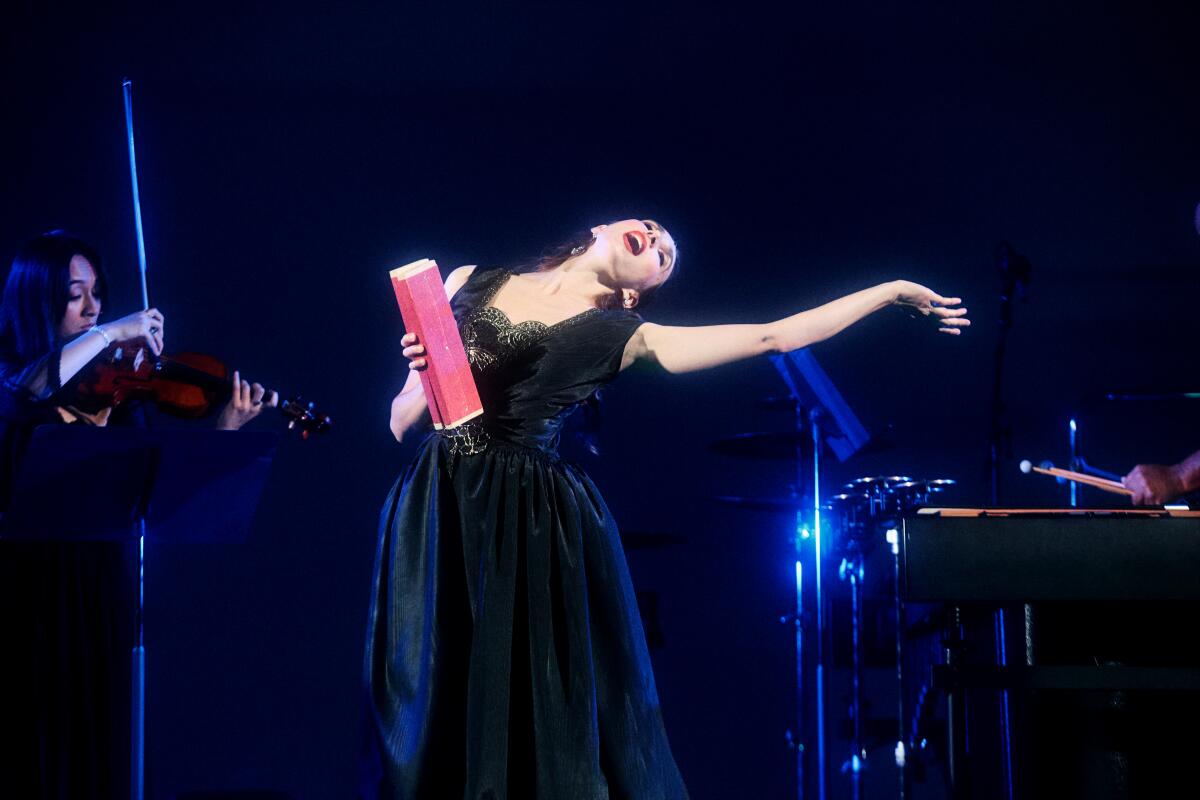
For the record:
1:16 p.m. June 6, 2024An earlier version of this article credited the production photo for “Ipsa Dixit” to the Art Theatre of Long Beach. The photo should be credited to Jason Al-Taan / Long Beach Opera.
“Tragedy,” the extraordinary soprano Anna Schubert sings in “Ipsa Dixit,” “is the imitation of an action whose practitioners may imitate things that are or were the case, things believed to be the case, and things that ought to be the case.” That is what Pacific Opera Project gets right. It is what Long Beach Opera, with radically different goals and approach, also gets right.
Long Beach Opera, our region’s oldest opera company, began as Long Beach Grand Opera in 1979. Those grand ambitions quickly proved preposterous, but in an operatic desert, anything is possible. The company switched gears and went avant-garde, becoming an essential purveyor of innovative new and modern opera.
“Ipsa Dixit” is Long Beach Opera‘s third Soper opera. The libretto by the composer is spoken and sung. It asks what art is — the asking spoken, the answers wildly sung and incomprehensible. You never know what is what, just that there are more questions from Greek philosophy and contemporary sources than answers.
Schubert is spectacular. She is accompanied by a trio of flute, percussion and violin. Director James Darrah added two dancers, Anne Souder and Leslie Andrea Williams, from the Martha Graham company, choreographed by Janet Eilber. The venue, the Art Theatre, is a former Long Beach silent movie palace, which Darrah acknowledged by using clips of eloquent suffering from Carl Theodor Dreyer’s 1928 “The Passion of Joan of Arc.”
Semi-modern dance, silent film, a postmodern libretto with ancient texts, a mad scene that lasts some 95 minutes — it’s a stretch. The alternation between analytic calm and hysteria can be exhausting. Yet somehow, through Soper’s brilliant vision and the high level of the production, “Ipsa Dixit” works, each element, each instrument becoming the right choice. It’s too long. Soper has her own unnecessary Alfano climactic ending. But one leaves the theater with much to take home.
OperaFest LA is enough to keep our visitors busy and, one hopes, intrigued. The expected grandeur, the time and space business, the big emotions, big ideas and big voices, we’ve got it all. That’s to be expected. But what really sets opera in L.A. apart is the art form’s movement in new and profound ways can come from the unexpected sources.
With better timing, the conference might have discovered the operatic elephant in the room is not from “Aida.” The L.A. Phil has become the most consequential opera company in America, be it with the transformative “Tristan Project,” the many new operas it has commissioned, such as Dylan Mattingly’s extraordinary and slightly mad six-hour “Stranger Love,” or the crucial revivals of America’s most original and neglected operas, which have included Lou Harrison’s “Young Caesar,” Meredith Monk’s “Atlas” and John Cage’s “Europeras 1 & 2”. This year alone, Gustavo Dudamel has overseen stagings of Wagner’s “Das Rheingold,” with Frank Gehry transforming his Walt Disney Concert Hall into America’s most congenial large opera house. Dudamel also led a “Fidelio” like none other, Beethoven’s opera illuminated with the help of deaf actors and chorus (which he just took on tour to Europe).
CalArts festival, DTLA theater, the Sci-Fi World mess in Santa Monica and a big change at the Academy Museum: Here’s everything that’s essential in L.A. arts.
The Industry, founded by Yuval Sharon, who (like Sellars) has worked extensively with the L.A. Phil, valiantly makes the impossible a matter of operatic life and death. June 14, at the Museum of Contemporary Art’s Geffen Contemporary, the Industry premieres “The Comet/Poppea,” Sharon’s concept of fusing Monteverdi with a new opera by George Lewis. The same weekend, the PARTCH Ensemble, which plays on the iconic instruments invented by the West Coast iconoclast Harry Partch, premieres new scenes from L.A. composer Anne LeBaron’s opera “LSD — Huxley’s Last Trip” at REDCAT. Sellars happens to be in the Bay Area, where he is staging Schoenberg’s “Erwartung” for Esa-Pekka Salonen and the San Francisco Symphony, carrying on Sellars and Salonen’s transformative operatic vision they began at the L.A. Phil.
To talk about opera in the 21st century and mean it, the trumpeting elephant stays in the room. Our world opera visitors can peer across Grand Avenue at Disney Hall and stroll over to the Geffen Contemporary, but they are missing what is happening inside that is making all the difference in the world.
More to Read
The biggest entertainment stories
Get our big stories about Hollywood, film, television, music, arts, culture and more right in your inbox as soon as they publish.
You may occasionally receive promotional content from the Los Angeles Times.
